Editor’s Note: This article was originally published in Overland Journal, Winter 2016
It was summer and we were excavating a pre-pottery neolithic site just outside Amman, Jordan. We began at sunrise to avoid the extreme heat of a zenith sun, labeled artifacts inside the dig house during midday, and headed back out for more digging in late afternoon. The initial Palestinian intifada was underway in Gaza and the West Bank; Jordanian police had raided our project, removing many of the laborers. Not the Jordanian university graduate students, but the local guys hired to swing picks and move dirt all day. I was the most junior archaeologist there, and one of only a few Westerners. I didn’t ask about the raid; nevertheless, the luxury of others doing the heavy digging abruptly ended. The next day, I was directed to open a new excavation area. “Welcome to archaeology, Bass. You’ve been forewarned.” The professor gestured to my assigned area and slapped me on the back before marching off, his desert boots kicking up trailing puffs of dust. I glanced at other nearby excavations and estimated how much dirt needed to be shifted to get down into primary cultural deposit. We were digging back 8,000 to 9,500 years ago, depending on where you were in the stratigraphy. I wondered how the toothbrushes and dental picks we used back at the department’s field school in California would come into play. Turns out they didn’t.
BASIC SAFETY AND TECHNIQUES
Always wear gloves, eye protection, and check a shovel’s serviceability before using it. Stiffer boots are preferable, not just for protecting the top of foot but also the sole. Hiking or running shoes will work in a pinch; if you are wearing sandals, switch over to more sturdy footwear.
STANCE AND POSTURE TIPS
- Establish a wide base of support near the excavation spot.
- Keep ankles everted and hips externally rotated.
- Hips should move into a hinge position with a slight bend in the knees. Buttocks move back as you lower (dead lift posture). Maintain a relatively upright torso, and open the chest up.
- Maintain a relatively upright torso, and open the chest up.
- Shoulders should be away from the ears, with the head slightly up. (Remember, the body will follow the head.)
Be mindful that every person is different, and certain body types may require adjustments in biomechanics. As fatigue sets in, your posture and form could be compromised, inadvertently pulling in accessory muscles to compensate. These secondary muscle groups will help you finish the job, but they may also lead to injury. Know your physical limits and modify your technique only when it’s appropriate.
In almost 30 years as a professional archaelologist, I’ve learned a few things about digging with hand tools, especially shovels. Whether it is an excavation in the war-torn Middle East or getting your 4WD out of a sand dune, digging with shovels is real manual labor. Add extreme environmental conditions such as sand, rain, or mud, and digging can become a very unpleasant experience. Shovels that are of inferior quality with a less than optimal design, or left rotting away on your roof rack, will not make your life easier.
For this review, the focus is on those optimized for typical four-wheel overland and expeditionary use. For instance, the shovel you would reach for to extract your stuck Mercedes W461 Geländewagen, as opposed to excavating a gas pipeline trench or tinkering in a vegetable garden. However, in this capacity, we are not limited to vehicle extrication, as a road may need to be widened or a ditch require filling to allow vehicle progress. You might also need to dig a latrine.
With vehicle-borne travel, it is not always possible to carry hand excavation gear suitable for all eventualities due to space and weight considerations. Maybe you are traversing the sands of Namibia or making a run across the muddy Australian Outback. You may be traveling on unimproved dirt roads in Eastern Europe, or taking a weekend trip through your local backwoods. The best approach is to have equipment that will get you through most scenarios.
Shovels are used for transferring, digging, or scraping dirt and other substances. As opposed to spades, shovel heads are more scooped and angled with vertical sides to haul and move dirt. Wide variations in quality and design are not always economically driven, as a blade shape or handle design required for digging through granitic soils might be far different than that needed for peat.
Handle Length and Materials
Moving a pile of soil from ground level into a bucket allows for a more upright digging technique and freedom of movement. A longer-handled model is most efficient for this type of work. In tight spots where full range motion is restricted, a shorter-handled version is preferred. These situations might include shoveling sand out from under a high-centered vehicle or cutting back a steep slope in a narrow creek bed. Since we are often digging in highly varied and confined areas, shorter-handled shovels are usually the best choice.
Wood-Handle Wood-handled shovels accessorize the bonnets, roof racks, and bumpers of off-highway vehicles globally. The drawback is that they frequently go without removal or inspection for long periods. Wood can degrade rapidly, splintering and cracking from weathering. If you do regular maintainance on your tools, or park in an environmentally forgiving environment, then this discussion is unnecessary. For the rest of us, the ensuing rotted handles, loose shovel head attachments, and cracked wood will be a problem.
Fiberglass Admittedly, fiberglass handles lack heirloom qualities, and come in colors like yellow or red. They don’t look the part like a woodhandled Carters does on a Camel Trophy Defender 110, and you probably won’t find replacements in a Peruvian jungle. However, for an externally mounted tool that must reliably deliver, fiberglass has its advantages. If quality is up to standard, it should not swell or crack. No matter the socket design, it requires minimal maintenance and can be repaired and painted as necessary. Fiberglass can be compromised from heavy or sharp objects rubbing against or falling onto the shaft, and direct contact with seawater and certain chemicals can cause degradation. However, I’ve had no problems.
D-grips and T-grips
A D-shaped grip is preferable on shorter-handled shovels. It allows you to pull or push on the blade with better control and provides a firm grip perpendicular to the centerline. A D-grip functions well with work gloves, mittens, or thicker cold climate gloves, whereas the T-grip can be cumbersome. The T-grip is an older design that has been somewhat surpassed on dirt shovels. Companies still make them, but it requires an acquired user preference, including slight digging technique modifications.
Open Versus Closed Socket
Open Socket Open socket shovels are easier and cheaper to manufacture than those with closed heads. Handles are inserted into a round, tapered, rolled steel socket that usually has a seam on the underside and an open end down by the blade. They are typically held inside the tapered socket by friction, rubber gaskets, and rivets. Open socket shovels can lack rigidity at the fulcrum point, where the socket attaches to the blade. This matters when prying or transferring heavy objects. Open sockets also collect dirt and moisture in the seam and open end. These downsides are close to moot when using a fiberglass handle.
Closed Socket Closed sockets are sealed at the socket terminus, where the neck of the shovel head connects to the blade; they require more manufacturing steps and are usually heavier than open sockets. Because there is no seam on closed sockets, debris will not collect, making them easier to clean. They also have a more rigid head design, and allow for more pressure to be put on the fulcrum, though the added weight can cause user fatigue.
Shovel Head, Lift Angle, and Step
For travel, we are mainly concerned with two head types: the #2 round point and the square.
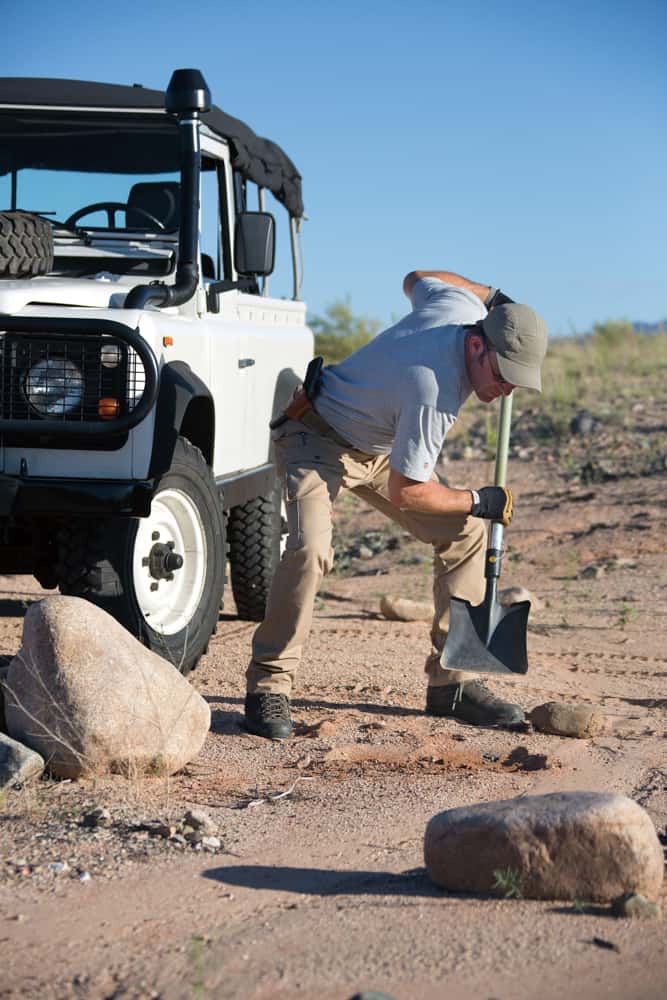

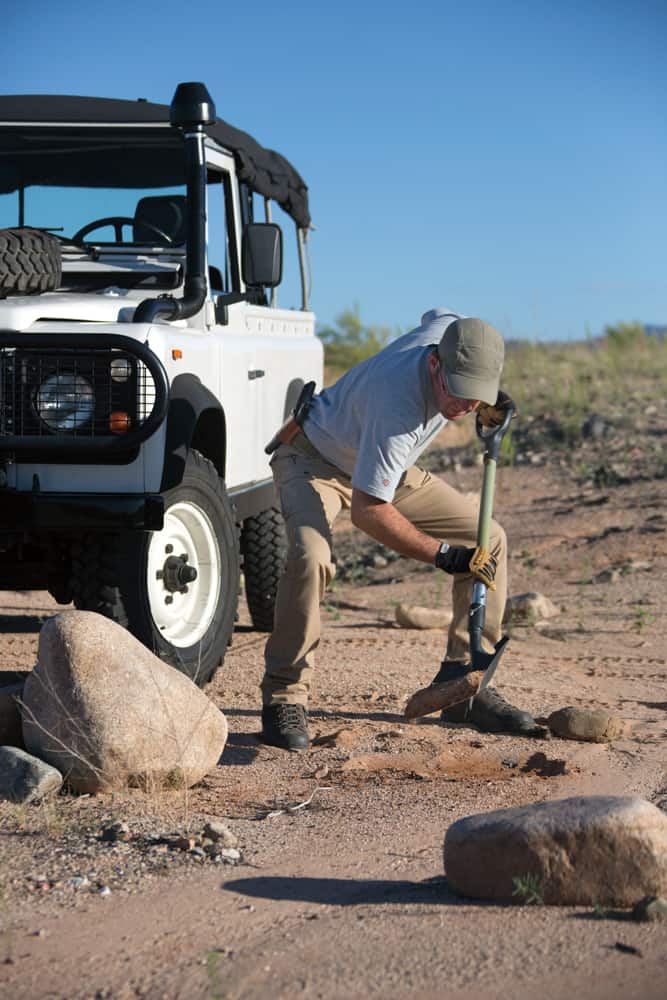
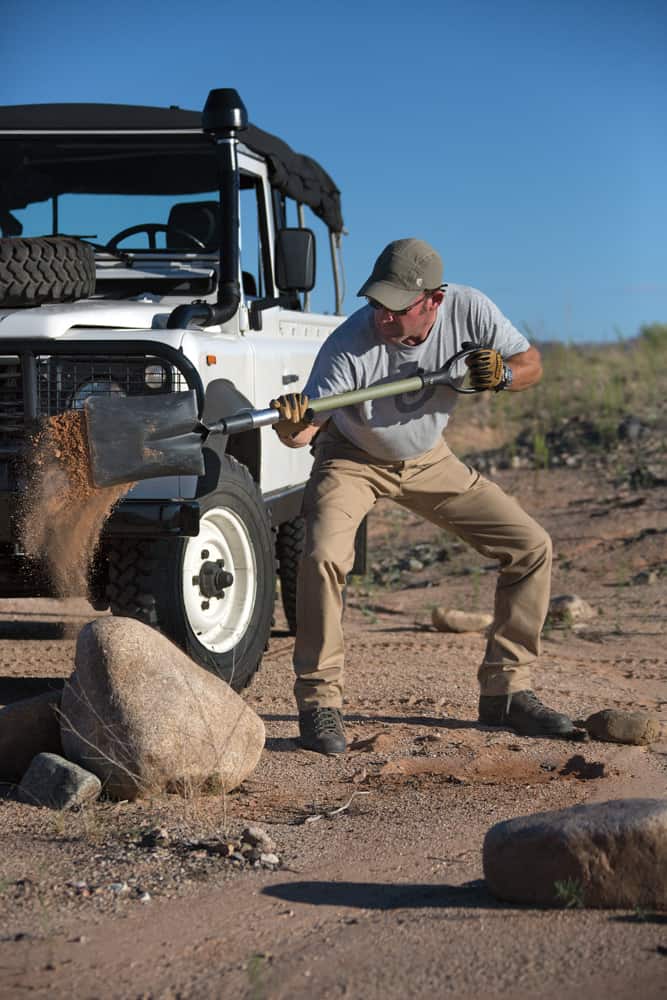
Pointed Tip The pointed tip can initially penetrate compact gravels, rocky soils, and cut through grass and mixed topsoil better than a square head. Once ground is broken, the pointed head will shift smaller quantities of material per scoop. They are prone to penetrate unevenly, and when contacting solid subsurface objects or pushing with a step, can deflect from the intended trajectory.
Square Shovel With a square shovel, it can be harder to make the initial penetration, especially in dense cobbles or harder top soils. However, the side points on a quality model can be used to initiate ground penetration. Square designs are also excellent for removing larger quantities of sediment with minimal loss of excavated materials, cut through roots and small branches better, are more easily sharpened in the field, and excel on vertical soil profiles (e.g. road cuts) and at shoveling snow. When turned over (blade down) or on its side, it is also better at pulling or pushing soils.
Lift Angle Lift angle relates to the height of the end of the handle when the blade is rested on flat ground. The higher the end, the less distance required to push down to level the blade and shift a load of dirt. Shovels intended for digging and removing soils have higher lift angles, evidenced by a more pronounced angle between the blade’s leading edge and handle centerline.
Step This feature on the back edge of the head provides the user’s foot a stable and comfortable platform for driving the shovel. Most steps have an L profile, and either angle toward the front of the blade or to the underside. The rear-angled step, whether L profile or rolled steel, tends to collect debris and catch along the face of narrow trenches as you dig. The forward-angled L step provides the same secure platform and will not snag when excavating or removing soils.
Gear Review and Testing
Ultimately, the only way to evaluate hand excavation gear is by using it. My assessments are based on ergonomics, build quality and materials, special design features, ability to withstand exposure to the elements, and efficiency in shifting materials. Each one has been put through similar scrutiny. In some cases, it may have been used extensively. In others, they were used enough to make valid, experience-based assessments. We did this one the old-fashioned way—by hand.
GRIP AND DIGGING TECHNIQUE (Medium Length Shovel)
This technique relies upon larger muscle groups in the arms, neck, shoulders, and back. There will be less repetitive motion strain on the wrist, elbow, and forearm, hence less chance of injury.
»» Use an overhand grip (palm down) on the hand closest to the shovel head. This grip increases tricep activation, which is a larger muscle group than biceps, and requires less rotation of your wrist and forearm when you dig (as opposed to palm up).
»» Lead foot should be the same side as the hand closest to the shovel head. »» Use an underhand grip (palm up) for the hand on the shovel’s D-grip.
»» Push arms forward, and stick the shovel into the ground at less than a 45-degree angle to surface.
»» Push your rear hand down as you level and raise the scoop with the hand closest to the shovel head.
»» Raise the blade, parallel with or slightly lower than the handle.
»» Rotate torso sideways in direction of your lead foot (right foot in the photo above).
»» Transfer soil with a fluid and relaxed arm motion. »» Return to initial position for the next scoop.
BULLY TOOLS
82520 14-Gauge Square Point $35
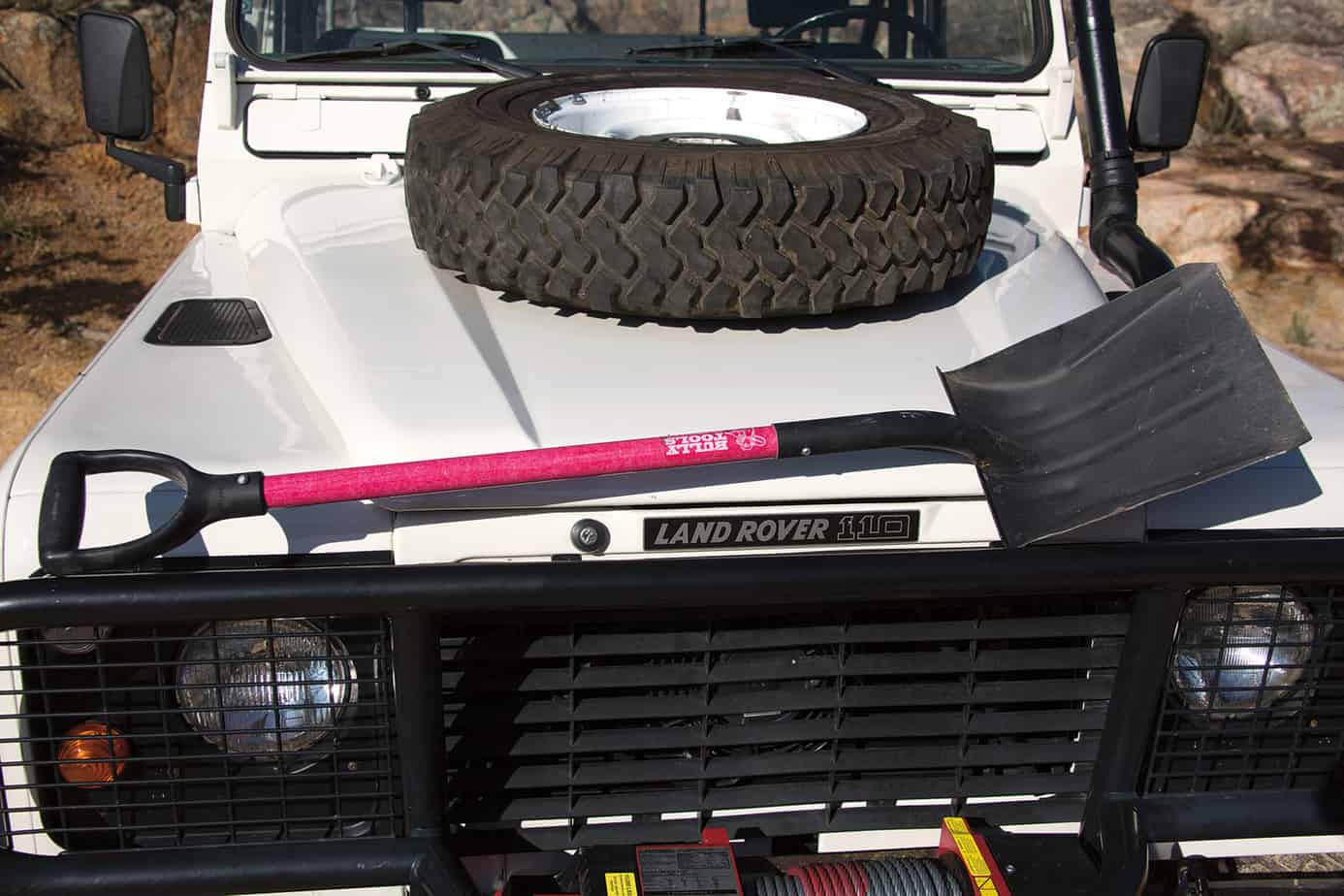
Founded in 1994, Bully Tools is an all-American company that has built its reputation on quality. Their modern factory allows them to conduct steel stamping, robotic-assisted welding, plasma cutting, metal tempering and heat treating, and powder coating operations all under one roof.
This 14-gauge square point shovel has a closed socket that keeps debris and water out of the metal neck, making it less prone to rust, while adding rigidity. A seamless neck attached to the head eliminates a common weak point found in other designs; it also has a box-beam profile which makes it less prone to flex. On the underside of the neck, Bully Tools adds what they call an I-beam: a steel gusset used to strengthen the welded tubular frame. The step, or footplate, has a forward angle that runs the entire length of the rear edge. This provides a wide foot purchase, and it won’t snag on roots or rocks.
The fiberglass handle has a triple- wall construction, including a full-length solid wood core for added strength and rigidity. A molded plastic design, the D-grip is held in place to the handle by a heavy rivet. It has a larger palm swell than others in this test and is lightly stippled for better grip. Overall length is 45.5 inches, and the blade measures 9.5 by 11.5 inches.
Their square blade design is noteworthy, with relatively straight sides that allow soil to be effectively pushed. Why does this matter? You’ve high centered your truck, and you stick a shovel under to clear some sand away. With a straight-sided version, the flat edge will move sand in a clean, productive manner. One with curved sides will leave a small mound where the curved edge passes over some of the sand, requiring yet another pass. A small nuance, yet important for efficiency.
Overall, the Bully has a solid feel. There is no play in the D-grip or the head, and there is a distinct lack of flex in the shorter D-grip fiberglass model. This translates to direct feedback between the tool and user to help mitigate fatigue. The gusset on the neck allows for more aggressive prying—important in an overland or expeditionary setting where you may have to improvise with available tools. This stout shovel excels at cutting roots and small saplings, and will hold up to excessive trail abuse, exposure to the elements, and general neglect. Made in USA, limited lifetime warranty. bullytools.com, 800-469-5522.
Pros
• Extremely robust
• Closed socket
• Well-engineered head
• Low cost
Cons
• Length may be a storage/
mounting concern
• Handle color
MAG-LOK TOOLS
16-Gauge # 2 Round Point
and Square (w/handle choice) $48-52

Mag-Lok Tools was founded almost 6 years ago, with manufacturing sites in Texas and Louisiana. CEO, Robert Mouch, developed a “one handle fits all” tool head system, and the company improved upon the concept. Driven by potential commercial and military applications, they have developed an extremely versatile interconnectable tool system. A unique component of the Mag-Lok system is the patented, aircraft- grade aluminum connector on the end of the handle. It has a sliding male fitting welded to the head that abuts a compression O-ring on the connector and prevents any movement of the head. The assembly is locked in place by a large, knurled thumbscrew with a sheer strength exceeding 8,000 pounds. A retaining wire tethers the thumbscrew to the aluminum connector. Mag-Lok says they have never experienced a connector failure, despite heavy commercial use.
The handle and grip combination that stands out for overland use is the D-grip with a 28-inch handle. Shafts are made from 1.25-inch diameter fiberglass tubing with a plastic, solid-core D-grip on one end and the aluminum Mag-Lok connector on the other. A 12-inch hickory dowel inside the fiberglass handle reinforces and extends the fatigue point, preventing failure during excessive prying. The D-grip is held in place by two flat hex screws that are thread-locked into place. Two variations are available: yellow fiberglass and green polymer. The green polymer handle, originally designed for military applications, has a coating described as waterproof and fire resistant by the manufacturer. This adds a stippled surface, providing a more tactile grip surface. Overall length with the square or round shovel head is 45 inches.
Welds on the head’s male adapters are reasonably clean and finished with a grinder. Afterwards, the head assembly is covered with protective paint. The 16-gauge round and square heads are designed with a forward step and have open sockets to keep them light and eliminate extra manufacturing costs.
I’ve been using various Mag-Loks for over a year, alternating between the round point and square shovel attachments on the 28-inch D-grip and 46- inch long-handled models. They’ve been used in construction trenches and archaeological test units, digging through sand, gravel, loam, and small cobbles. I prefer the square as it is a more versatile design, but both shift dirt well, and the lift angle provides excellent ergonomics. The step isn’t rough on boots, and the grip is solid. When turned on its side to push dirt, the square blade passes over some soils due to the slight curve along the sides.
One squawk involves the rubber compression O-rings on the aluminum connector, which eventually cracked. Silicone rubber O-rings might mitigate this issue. We used plastic shims and poor-fitting O-rings to make expedient repairs until replacements from Mag-Lok were received. Lesson learned—carry spares. Mag-Lok also has an exceptional guarantee: If a tool breaks for any reason, they replace it. No fine print. Made in USA, lifetime warranty. magloktools.com, 855-255-2345.
Pros
• Innovative modular design
• Easily disassembled to
save space
• Cost
• Warranty
Cons
• May require periodic
replacement of O-rings
• Requires minor moving
parts
CARTERS
General Service Pointed $50
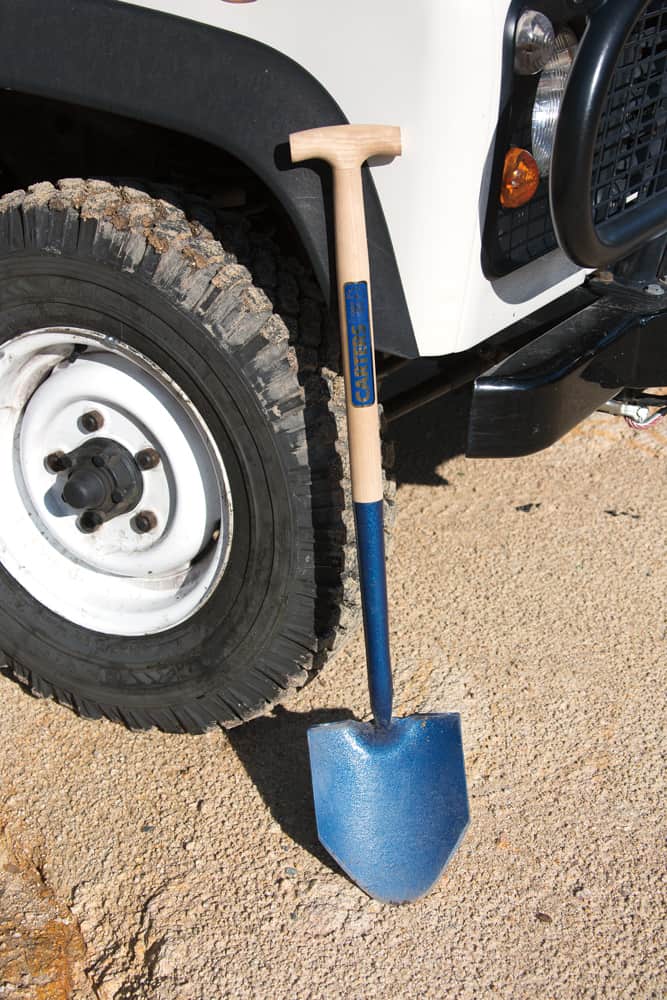
Founded by Jeremiah Carter, Carters began manufacturing tools in the U.K. in 1740. During the company’s long heritage, they’ve supplied British troops during both World Wars and provided tools to the coal mining industry. In 1999, Managing Director Richard Carter III, a direct descendant of Jeremiah, moved Richard Carters Ltd. to a state-of-theart factory at Neiley Works in Honley, West Yorkshire.
The shovel for this review is an old standard: the solid socket, treaded, general service pointed blade with an ash T-shaped handle. The Carters catalog calls it out as a popular Ministry of Defence (MOD), Land Rover, and expedition shovel. The 8- by 10.5-inch head is the smallest in this review, and the shovel’s overall length is a compact 37.5 inches, making it handy in tight spots—especially under bumpers, frames, and chassis. Solid socket shovels, like closed sockets, perform best when used for light prying, excavating compact soils, and transferring heavy materials. The general service blade is unique, as it’s more pointed than a typical round point and the sides are parallel, similar to a square shovel. The blade penetrates well due to its size, shape, and heavier weight. The step, or foot tread as Carters calls it, is small yet functional.
Made from a single piece of double roll-formed carbon steel, it appears to be slightly thicker than 14 gauge. The socket and blade are forged as one piece, making it very rugged as there are no welds to crack or rust. The socket runs just under halfway up the ash shaft, allowing for serious leverage to be exerted. There is a thin, open seam down the full length of the socket’s underside, and the end, while tapered, is slightly open.
Carters calls the handle T crutch shaped. It has an ergonomic top curve and the underside has a comfortable profile. The grip and shaft are mortised and tenoned to fit, and then secured with waterproof glue. Finally, a wooden dowel is hammered in to secure the grip.
The fit and finish on the ash handle are nice, but the rivet on the upper part of the socket isn’t the cleanest. I have used the Carters as an all-around field shovel and for excavating archaeological test trenches. It definitely meets expectations for general use and gets the job done.
It is also the heaviest shovel in this review, which can work in your favor, especially on quick tasks where the weight and point are brought to bear. However, longer duration digging will be fatiguing, due also to the shorter overall length, shallow lift angle, and lower volume of soils transferred by the head. Crack a West Yorkshire beer and ask a buddy to finish the job. If Overland Journal had a Lifetime Service Award, the Carter would win it. Made in the U.K., 1-year limited warranty from Rovers North (U.S. distributor). roversnorth.com, richardcarterltd.co.uk, 800-403-7591.
Pros
• Robust, classic design
• Significant pedigree
• Compact
• Cost
Cons
• Solid socket open to debris
• Weight
• Small shovel blade
• Wood handle
• Limited availability outside
the U.K.
AMPCO SAFETY TOOLS
S-84FG Square Point $250-391
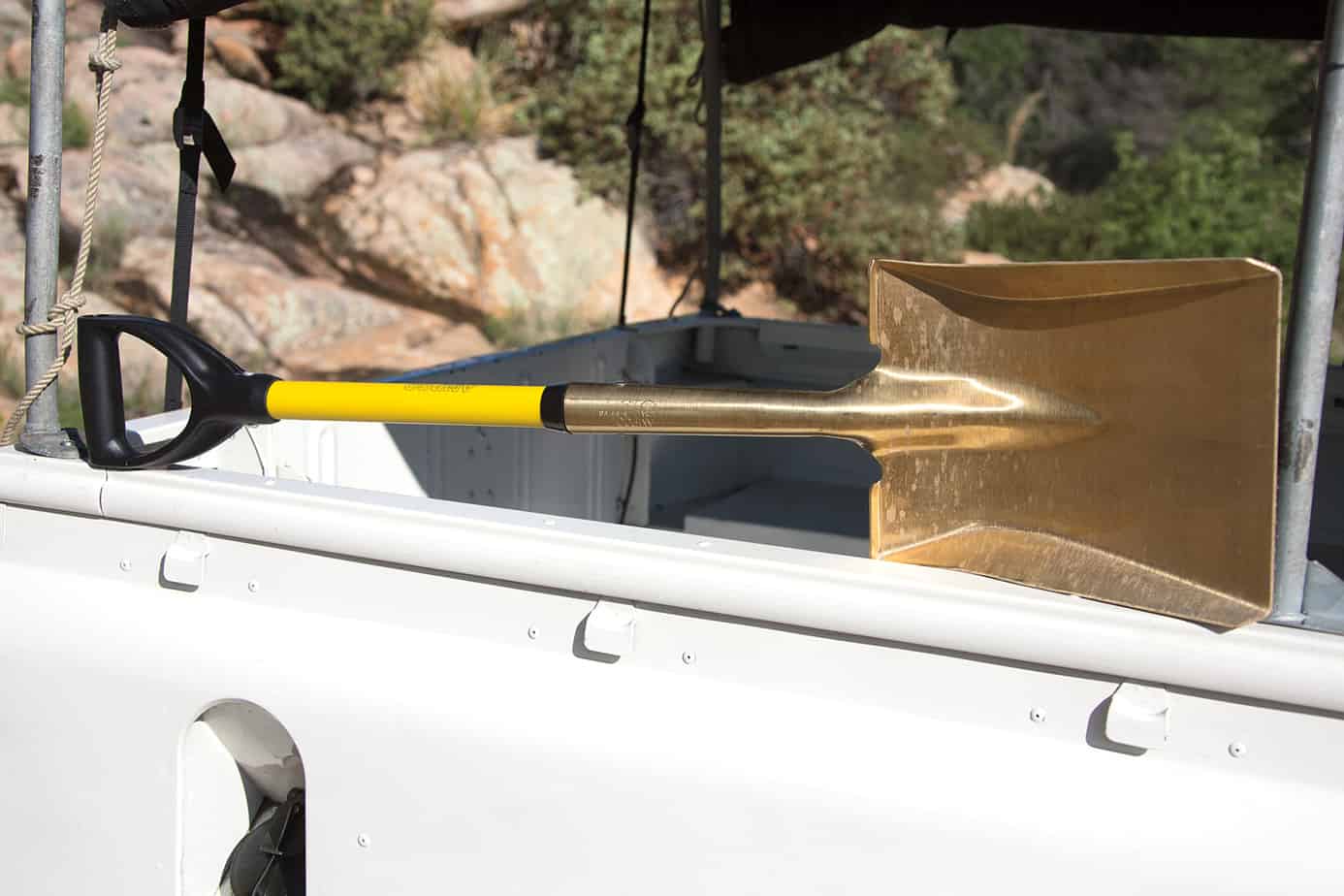
Lamborghini once made a 4WD like no other: the LM002. With a manual 5-speed transmission bolted to a V12 motor borrowed from the venerable Countach, only 301 of these off-pavement beauties were ever produced. What shovel would be mounted to this Italian rarity? Will the Lamborghini SUV of shovels please rise.
Enter the Ampco S-84FG. The 9- by 11-inch blade is a standard size, and the overall length from the D-grip to blade edge is a handy 37 inches. Here is where the specifications get interesting. The blade is made of an aluminum bronze copper alloy that is nonsparking, nonmagnetic, and corrosion resistant. It also meets or exceeds the National Fire Prevention Association (NFPA), Deutsches Institut für Normung (DIN), Mine Safety and Health Administration (MSHA), Department of Energy (DOE), and U.S. military specifications. Don’t bring it into direct contact with acetylene, as this may precipitate the formation of explosive acetylides, and you wouldn’t want those around the campfire.
The S-84FG has an open socket design. The fiberglass handle firmly seats into the socket with a dedicated rubber gasket on the upper end (toward the D-grip), and a tapered rubber stopper assembly on the lower end. The grip is solid plastic and attaches to the upper end of the handle by a robust rivet. The Dgrip is at some variance with the black plastic grips on the Bully Tools and Mag-Lok shovels. It fits comfortably in the hand, and has more material in areas that would typically come under stress from transferring heavier loads or prying. The grip function and materials used are surely dictated by the aforementioned laundry list of standards.
The step, which is a standard 0.5 inch wide, has a forward angle that is ideal for backcountry use. The sides are reasonably straight and similar to those on the Bully and Ace models: great for pushing sand out from under your stuck LM002. The fit and finish on the Ampco are superb, and the neck includes an “FM” stamp inside of a 4-sided diamond, a symbol for internationally recognized thirdparty testing and certification.
This product fits well in the hands and feels more solid and better balanced than the others; this is a testament to the company’s attention to even the smallest manufacturing details. The aluminum bronze copper alloy blade does make the S-84FG look akin to a ceremonial shovel for breaking ground at a new building site. I’m sure if the International Space Station needed a shovel sent up, this would be it. At this price, you’re definitely not going to loan it out though, and you might think twice before mounting it on the outside of your vehicle—unless it’s a Lamborghini. Made in USA, limited lifetime warranty. ampcosafetytools.com, 800-580-9835.
ACE HARDWARE
Square Point 70013 $26

This review would not be complete if we didn’t include a common, off-the-rack shovel from a hardware store. Purchased about 1 year ago for general gardening and landscaping, it was left outside in the elements for the entire time. It should be noted that this particular model is not available online, but can be sourced from Ace’s brick and mortar locations.
Overall length is 45 inches, and it is made of thin, stamped steel, with an open-back socket. The rivet that goes through the neck and holds the handle in place appears quite solid. The forward angled steps are unique, as they extend well beyond typical industry standards. While steps on other shovels reviewed are in the 0.5-inch range, these protrude 1.75 inches. They are seemingly gentler on hiking boot soles, whose treads are not always as heavy-duty as work boots. Louvers are cut into the steps, presumably to shed mud and debris, and for added grip.
The handle appears to be lightly varnished ash (the finish has since stripped away), and does not protrude out the bottom of the socket. This will keep some moisture and dirt off the wood. However, by positioning the handle so far up into the open socket (about 4 inches), the fulcrum point lacks added rigidity. This would definitely present a problem if used for excessive prying, especially with full body weight applied to the upper handle.
The D-grip utilized is quite different from the others in this review. The frame is metal and attached to the handle with two rivets, but the actual cross member that the hand grabs is wood. The metal in the grip frame is thin, and the seam that runs around the outside is uneven. Overall, the grip assembly is poorly designed and of inferior construction.
The head on the Ace Hardware model is actually a good design, and the larger step works well. With the exception of the step, the shape is most similar to the square Mag-Lok. However, the materials used are clearly of a lower grade. The steel is much thinner than 16 gauge; it feels handy but a bit light in comparison. In use, it performs adequately enough. However, there is a slight amount of free play where the handle attaches to the grip and in the wood cross grip. This movement is also felt when digging.
If it had not been stored outside it would be in better shape. The wood doesn’t appear to be of lesser quality, and other wooden- handled shovels probably would have suffered too. It has dried out, the grain is starting to separate, and splinters are not too far off. This certainly has some good service life left, but will need attention soon. Made in Mexico, warranty varies by individual store. acehardware.com, 866-290-5334.
Pros
• Extremely solid, well balanced
feel
• Compact
• Superior construction
• Wide blade for its size
Cons
• Cost
• Step could be wider
(to match larger blade)
Conclusions
I own all the shovels reviewed here and use them (along with many others) on a regular basis for professional and personal applications. Nothing was sent pro bono by a manufacturer. Sometimes, I intentionally use the “wrong” shovel to see how it performs under conditions for which it probably wasn’t designed. It is under these conditions that many of the shovels were tested, because with the possible exception of the Carters, none are made specifically for overland or expeditionary use.
It is great to talk about penetrating compact soils or gravels. However, you would more likely be stuck in loose soils and sand. Therefore, you should probably have a shovel that excels in the latter material. Before you choose one, contemplate your capabilities and the intended operating environments.
The Ace Hardware shovel is affordable and works as intended. I don’t believe it will hold up under heavy prying or after long exposure to weather though. It is of significantly lesser quality, but it’s not really much of a financial hit to purchase instead of a Bully, Carters, or Mag-Lok.
The Carters doesn’t need to prove itself, having seen combat, coal mines, and Camel Trophy races. They are also heavy and fatiguing, and have a a small head. The wood T-grip certainly isn’t as comfortable as a Dgrip, but it is what it is: a general service shovel.
The Ampco S-84FG specifications and intriguing standards go way beyond anything most people would need. The price isn’t insane if you require a nonsparking, nonmagnetic, and corrosion resistant shovel with demonstrable certified industry credentials.
The Mag-Lok system has an innovative modular design, and is intended for commercial and military use. Being able to swap out standard heads opens up new possibilities. With a square and pointed blade and one D-grip handle, you should be able to deal with anything typically encountered in backcountry settings. Store a spare handle somewhere, and you’ll essentially have a backup shovel available. Mag-Lok receives the Value Award because their featured shovels are affordable, extremely versatile, and let you adapt without significant weight or space changes to your current vehicle configuration. Mag-Lok also has other attachments (not reviewed here), and an excellent lifetime warranty.
The Bully is longer than the others, which means a slightly more comfortable digging posture. This is very important. However, it will still fit where most shovels get stored, in or on our vehicles. The head is, beyond doubt, overbuilt. The entire fiberglass handle is reinforced with a wood core. Overall, it is extremely solid, which is perfect for using it not as intended. We all know how it goes out in the middle of nowhere: you may need to improvise and push a tool to its limit, and the Bully will take it. There are no moving parts or pieces to go missing. I give it the Editor’s Choice Award.


